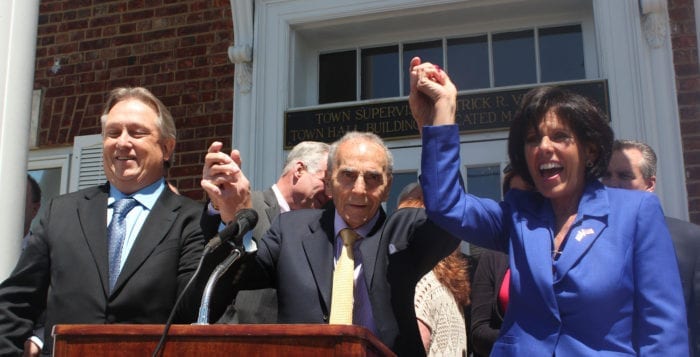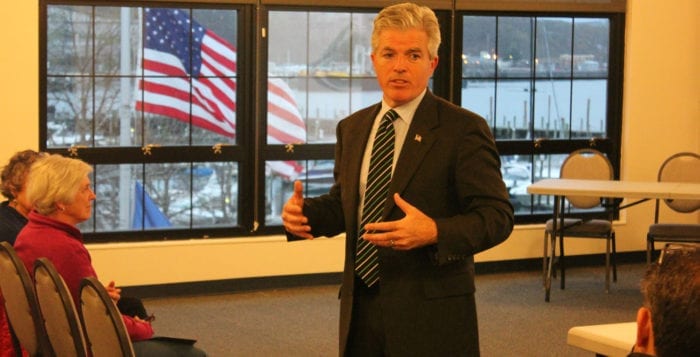A decade of hard work by a former mayor, and plenty of pavement-pounding by his two daughters, will result in a lasting memorial. The Port Jefferson Village board of trustees unanimously voted to approve a proposal brought forth by Lauren and Maddy Sheprow to rename the Port Jefferson Country Club at Harbor Hills after their father Hal Sheprow, who was elected mayor in 1977.
“The Village of Port Jefferson wishes to memorialize Mayor Sheprow’s pivotal role in acquiring the Harbor Hills Country Club … positively impacting village property values and improving quality of life through his actions taken to acquire a recreational asset for current and future generations, by officially renaming the Port Jefferson Country Club at Harbor Hills to The Harold J. Sheprow Port Jefferson Country Club,” the resolution from a May 1 board meeting reads.

During the meeting, Sheprow’s daughters made a presentation to the board which included the steps their father had taken to ultimately purchase the then-privately owned golf course from Norman Winston, a real estate developer with properties around the world.
In 1969, Sheprow was a village resident who wanted a private beach for himself and his neighbors to enjoy other than the one owned by the country club, which was only accessible after payment of a $90 annual fee. That year, according to the Sheprows, the fee tripled, making it very difficult for working families to afford. That was his first foray into local politics.
In 1970, Sheprow joined the planning board and began looking into acquiring a beach for the village. He ran for mayor the next year, but was defeated. In 1974, he was elected to the board of trustees, and eventually became mayor in 1977. In July he was sworn in, and in October Winston died. Throughout his time working for the village in various capacities, he never gave up his goal of securing a private beach for Port Jeff residents.
After Winston’s death, according to the Sheprow daughters, the golf club fell into disrepair and became a blight on the vast Winston estate, which included the 128-acre golf course and a mile and a half of beachfront property. Sheprow saw it as a perfect opportunity to achieve his nearly decade-long goal.
“He didn’t want developers coming in and just reusing the land and building condominiums or whatever,” Maddy Sheprow said during the presentation. She said her father tried repeatedly to get a meeting with Morgan Stanley, the bank in charge of the Winston estate, but was unsuccessful.
By February 1978, Sheprow had reached “his wit’s end,” according to his daughters.
“My mom, Peggy Sheprow, had come to him and said, ‘Shep, we’re going to a party — it’s in New Jersey,’” Lauren Sheprow said. “And he said ‘I’m not going to any party. I’m trying to get this done and I can’t even think about anything else. I can’t entertain the idea of being entertained. I’m not going to a party.’ She said, ‘no, you’re coming. My cousin Dolly is having a party and we’re going.’”
At the party, Sheprow was introduced by chance to the vice president of real estate development at Morgan Guaranteed Trust, one of the trustees of the Winston Estate. The two set up a meeting, and eventually agreed to a one-year lease for $1 between the estate and the village, so that Sheprow could take all of the necessary steps to get the purchase of the property, valued at about $2.3 million at the time, to a community vote. The contract was written up on a $1 bill and remains in Sheprow’s possession until this day.
At the first public meeting, more than 200 village residents showed up to weigh in.
“One of the big parts of their plan was to make sure that they communicated the value, the benefit, the ongoing need for this village to acquire this property and an understanding of what that meant,” Maddy Sheprow said. “That communication was a hallmark of what allowed this to move forward.”

The plan wasn’t without its share of dissenters. Current village trustee Bruce Miller who lived in the village at the time — and voted yes on the purchase — said there were some who believed the land wasn’t worth its sticker price, and thought the abundance of available land in Port Jeff would mean the price would drop in time.
On May 2, 1978, 1,508 of the approximately 2,400 village residents participated in the historic vote, which passed by a 3-2 margin.
“It wasn’t a slam-dunk — there was a lot of unhappy residents arguing about taxes being raised and arguing about the lack of need for this in the country club,” Maddy Sheprow said.
About nine years from when he had originally set out to explore the possibility of Port Jeff Village owning a private beach, Sheprow had achieved his goal and then some.
“Unfortunately most of the people that were involved in this at the time are gone,” Hal Sheprow said in a phone interview. “I don’t really even know how to express it. I’m so proud of my daughters … they did it on their own. I couldn’t be prouder of them for what they’re doing. What they’re doing — I absolutely never thought about it and never expected anything like this.”
Maddy Sheprow explained the thinking behind her and her sister’s efforts.
“We really felt that we were the only people that knew all of these details,” she said. “We felt like it was really important to somehow solidify that history and the legacy of my father’s administration and the work it put in to maintain the amazing and pristine property for the betterment of life for Port Jeff Village residents.”
The resolution was passed unanimously, and the Sheprows thanked the trustees and Mayor Margot Garant for their interest and enthusiasm in honoring their father. A ceremony will be held in July to make the change official.
Hal Sheprow offered some advice to future visitors of the newly renamed club.
“To those people who go to the club, hit them straight,” he said. “I hope they enjoy it after I’m gone.”






















 In a previous interview, Zeldin spokesperson Jennifer DiSiena said requesting a town hall with the purpose of disrupting it is wrong and wouldn’t be taken seriously.
In a previous interview, Zeldin spokesperson Jennifer DiSiena said requesting a town hall with the purpose of disrupting it is wrong and wouldn’t be taken seriously.



